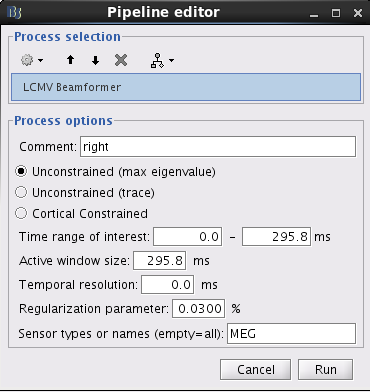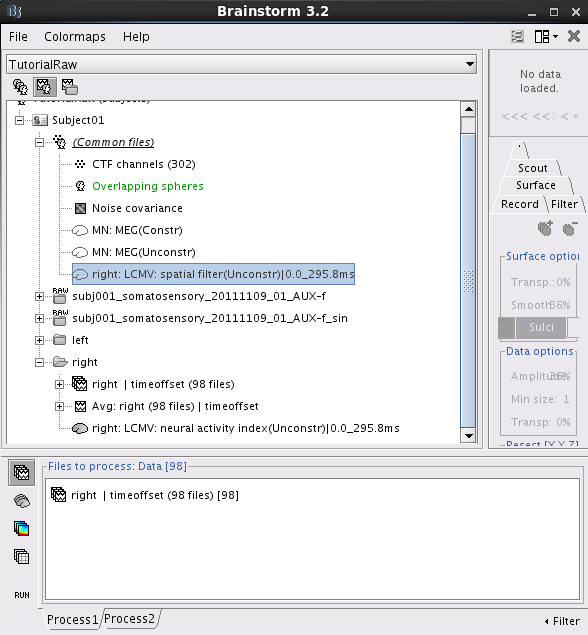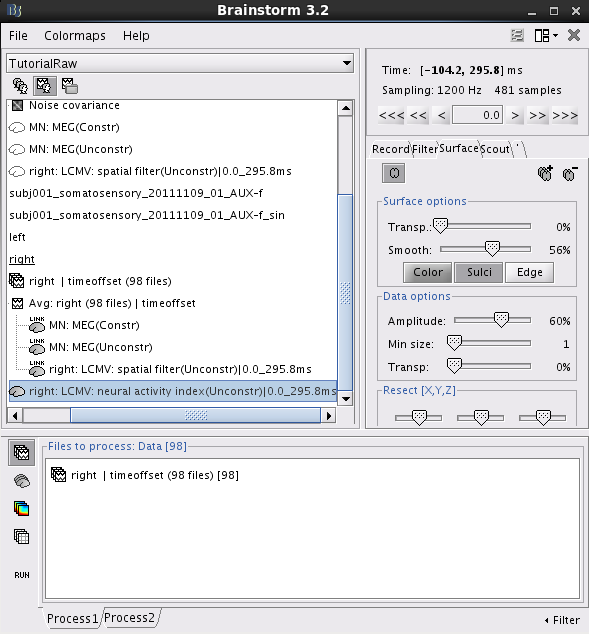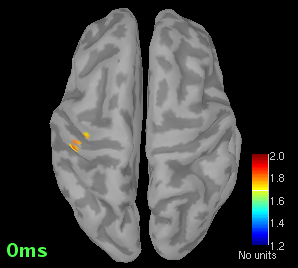|
Size: 8526
Comment:
|
Size: 8502
Comment:
|
| Deletions are marked like this. | Additions are marked like this. |
| Line 67: | Line 67: |
| * right: LCMV: neural activity index(Unconstr)|0.0_295.8ms(ws:296ms): Please <<BR>><<BR>> {{attachment:NAIright2.png}} <<BR>> <<BR>>Double click on this file. Right click on anywhere of the pop-up window. Select Colormap:Sources > Maximum: Custom.... Set the Minimum to be 1.2 and the Maximum to be 2.0. Click Ok. <<BR>> [[attachment:Colormaplimit|]]<<attachment:Colormaplimit.png>> <<BR>> <<BR>>Set the time to be anytime between 0 and 295.8 ms. Then click Surface on the right panel of database explorer. Set the Amplitude to be 60%. The distribution of neural activity index displays strong activation in the left sensory area. <<BR>> {{attachment:NAIrightmap4.png}} <<BR>><<BR>> |
* right: LCMV: neural activity index(Unconstr)|0.0_295.8ms(ws:296ms): Please <<BR>><<BR>> {{attachment:NAIright2.png}} <<BR>> <<BR>> Double click on this file. Right click on anywhere of the pop-up window. Select Colormap:Sources > Maximum: Custom.... Set the Minimum to be 1.2 and the Maximum to be 2.0. Click Ok. <<BR>> <<attachment:Colormaplimit.png>> <<BR>> <<BR>> Set the time to be anytime between 0 and 295.8 ms. Then click Surface on the right panel of database explorer. Set the Amplitude to be 60%. The distribution of neural activity index displays strong activation in the left sensory area. <<BR>> {{attachment:NAIrightmap4.png}} <<BR>><<BR>> |
Beamforming methods
Authors: Hui-Ling Chan, Francois Tadel, Sylvain Baillet
The estimation of source distribtion is an important step to understand the brain activity from EEG and MEG data. Dipole fitting, minimum norm estimation, and beamformer are three commonly used methods. It has been proved that beamforming methods provide good spatial resolution. This tutorial will show how to apply beamforming methods to MEG data and obtain the statistic map of source activation.
We are going to use the protocol TutorialRaw created in the previous tutorial ?Epoching and Averaging. If you have not followed this tutorial yet, please do it now.
Contents
Introduction
Beamfoming methods scan each targeted voxel/vertex position  and estimate the spatial filter
and estimate the spatial filter  . By multiplying with the MEG recordings
. By multiplying with the MEG recordings  , the spatial filter
, the spatial filter  outputs the temporal waveform
outputs the temporal waveform  of the dipole source at that position with the dipole orientation
of the dipole source at that position with the dipole orientation  as below:
as below:

where 'T' indicates the transpose of a matrix or vector. The beamforming spatial filter can be vector type or scalar type.
Vector-type beamformer
For each position  , three orthogonal spatial filters
, three orthogonal spatial filters ![$\mathbf{W}_{\mathbf{r}}=\left[\mathbf{w}_{\mathbf{r},\mathbf{q}_x},\mathbf{w}_{\mathbf{r},\mathbf{q}_y},\mathbf{w}_{\mathbf{r},\mathbf{q}_z}\right]$ $\mathbf{W}_{\mathbf{r}}=\left[\mathbf{w}_{\mathbf{r},\mathbf{q}_x},\mathbf{w}_{\mathbf{r},\mathbf{q}_y},\mathbf{w}_{\mathbf{r},\mathbf{q}_z}\right]$](/brainstorm/Tutorials/Beamformers?action=AttachFile&do=get&target=latex_2d3ac467d26334f39241546468515832d42349b6_p1.png) are computed by applying the unit-gain constraint as well as the minimum norm and minimum variance criteria as below:
are computed by applying the unit-gain constraint as well as the minimum norm and minimum variance criteria as below:

where  is the covariance matrix of MEG recordings during window
is the covariance matrix of MEG recordings during window  ,
,  is the identity matrix,
is the identity matrix,  is the gain matrix for the dipole located at position
is the gain matrix for the dipole located at position  , and
, and  is the regularization parameter which compromises the minimum norm and minimum variance criteria.
is the regularization parameter which compromises the minimum norm and minimum variance criteria.
Scalar-type beamformer
For each position  , the source orientation
, the source orientation  is first estimated to enable the spatial filter to output the source activity with maxmum power or fitting some other criteria.The estiamted dipole orientation
is first estimated to enable the spatial filter to output the source activity with maxmum power or fitting some other criteria.The estiamted dipole orientation  is then applied to calculate the spatial filter as follows:
is then applied to calculate the spatial filter as follows:

Linearly-constrained minimum variance (LCMV) beamformer
LCMV beamformer is vector-type beamformer. For each position  , this method calculates the neural activity index, which is interpreted as the estimate of source to noise variance.
, this method calculates the neural activity index, which is interpreted as the estimate of source to noise variance.
Neural activity index
For each position  , the variance of source activity during active state
, the variance of source activity during active state  is calculated as follows:
is calculated as follows:
![$ \rm{Var}_{\rm a}(\bf r) =trace \left \{\left[{\bf L}_{\bf r}^{\rm T}{\bf C}_{\rm a}{\bf L}_{\bf r}\right]^{-1}\right \}\enspace, $ $ \rm{Var}_{\rm a}(\bf r) =trace \left \{\left[{\bf L}_{\bf r}^{\rm T}{\bf C}_{\rm a}{\bf L}_{\bf r}\right]^{-1}\right \}\enspace, $](/brainstorm/Tutorials/Beamformers?action=AttachFile&do=get&target=latex_cb2e09fb09a948bd8f3590a5fb5ec78b3f485b92_p1.png)
or
![$ \rm{Var}_{\rm a}(\bf r) =\lambda_1 \left \{\left[{\bf L}_{\bf r}^{\rm T}{\bf C}_{\rm a}{\bf L}_{\bf r}\right]^{-1}\right \}\enspace, $ $ \rm{Var}_{\rm a}(\bf r) =\lambda_1 \left \{\left[{\bf L}_{\bf r}^{\rm T}{\bf C}_{\rm a}{\bf L}_{\bf r}\right]^{-1}\right \}\enspace, $](/brainstorm/Tutorials/Beamformers?action=AttachFile&do=get&target=latex_a4850818772e2ccb0091762ad12b2ea377c4bd92_p1.png)
where  is the covariance matrix computed from MEG recordings during active state
is the covariance matrix computed from MEG recordings during active state  and
and  indicates the maximum eigenvalue of the expression in braces.
indicates the maximum eigenvalue of the expression in braces.
When the location  is far from sensors, the elements of lead field matrix
is far from sensors, the elements of lead field matrix  are small. So the elements of
are small. So the elements of ![$\left[{\bf L}_{\bf r}^{\rm T}{\bf C}_{\rm a}{\bf L}_{\bf r}\right]^{-1}$ $\left[{\bf L}_{\bf r}^{\rm T}{\bf C}_{\rm a}{\bf L}_{\bf r}\right]^{-1}$](/brainstorm/Tutorials/Beamformers?action=AttachFile&do=get&target=latex_6f70bec44ed33947d8956368ab78866325802ce0_p1.png) are generally large and the estimated variance for the deep source becomes large. When the location
are generally large and the estimated variance for the deep source becomes large. When the location  is close to sensors, the elements of lead field matrix
is close to sensors, the elements of lead field matrix  are large. It results in small values of the elements of
are large. It results in small values of the elements of ![$\left[{\bf L}_{\bf r}^{\rm T}{\bf C}_{\rm a}{\bf L}_{\bf r}\right]^{-1}$ $\left[{\bf L}_{\bf r}^{\rm T}{\bf C}_{\rm a}{\bf L}_{\bf r}\right]^{-1}$](/brainstorm/Tutorials/Beamformers?action=AttachFile&do=get&target=latex_6f70bec44ed33947d8956368ab78866325802ce0_p1.png) and small estimated variance for the superficial source. To reduce the effect caused by the depth of source location, the estimated source variance
and small estimated variance for the superficial source. To reduce the effect caused by the depth of source location, the estimated source variance  is normalized by the noise variance
is normalized by the noise variance  as follows:
as follows:
![$ \rm{Var}_{\rm N}(\bf r) =\frac{\rm{trace} \left \{\left[{\bf L}_{\bf r}^{\rm T}{\bf C}_{\rm a}{\bf L}_{\bf r}\right]^{-1}\right \}}{\rm{trace} \left \{\left[{\bf L}_{\bf r}^{\rm T}{\bf C}_{\rm c}{\bf L}_{\bf r}\right]^{-1}\right \}}\enspace, $ $ \rm{Var}_{\rm N}(\bf r) =\frac{\rm{trace} \left \{\left[{\bf L}_{\bf r}^{\rm T}{\bf C}_{\rm a}{\bf L}_{\bf r}\right]^{-1}\right \}}{\rm{trace} \left \{\left[{\bf L}_{\bf r}^{\rm T}{\bf C}_{\rm c}{\bf L}_{\bf r}\right]^{-1}\right \}}\enspace, $](/brainstorm/Tutorials/Beamformers?action=AttachFile&do=get&target=latex_3daae73b23ee47f5968097f0fc12301d0b864f30_p1.png)
or
![$ \rm{Var}_{\rm N}(\bf r) =\frac{\lambda_1 \left \{\left[{\bf L}_{\bf r}^{\rm T}{\bf C}_{\rm a}{\bf L}_{\bf r}\right]^{-1}\right \}}{\lambda_1 \left \{\left[{\bf L}_{\bf r}^{\rm T}{\bf C}_{\rm c}{\bf L}_{\bf r}\right]^{-1}\right \}}\enspace, $ $ \rm{Var}_{\rm N}(\bf r) =\frac{\lambda_1 \left \{\left[{\bf L}_{\bf r}^{\rm T}{\bf C}_{\rm a}{\bf L}_{\bf r}\right]^{-1}\right \}}{\lambda_1 \left \{\left[{\bf L}_{\bf r}^{\rm T}{\bf C}_{\rm c}{\bf L}_{\bf r}\right]^{-1}\right \}}\enspace, $](/brainstorm/Tutorials/Beamformers?action=AttachFile&do=get&target=latex_511814276cf57828c3dcb343ee8f32abe3a78038_p1.png)
where  is the covariance matrix computed from MEG recordings during control state
is the covariance matrix computed from MEG recordings during control state  . The normalized variance
. The normalized variance  is called neural activity index (NAI).
is called neural activity index (NAI).
Compute Neural Activty Index for a sets of epoches
Drag and drop all of the epoches in Subject01 / right / right | timeoffset (98 files) into Process1.
Left click on RUN and choose Sources > LCMV Beamformer' in Pipeline editor.

With this window you can select the method you want to use to estimate the source variance and noise variance, the time window of active state, and the sensors you are going to use for this estimation. You can edit the following options:
- Comment: This field contains what is going to be displayed in the database explorer.
Method: Please select Unconstrained (max eigenvalue). This method calculates the variances of source activity and noise by using the maximum eigenvalue. The method Unconstrained (trace) calculates the variances of source activity and noise by using trace. The method Cortial Constrained use the orientation of cortical surface as dipole orientation. The unconstrained methods may give more smooth results than the cortical constrained method.
- Time window of active state:
Regularization parameter: This value will be multiplied with the maximum eigenvalue of the covariance matrix computed from the recordings during Time range of interest. The larger value of regularization parameter may give the more smooth results.
- Sensors type: Modalities that are used for the reconstruction. Here we only have one type of MEG sensors, so nothing to change.
Click on Run.
Two new files are available in the database explorer.
right: LCMV: spatial filter(Unconstr)|0.0_295.8ms: This field

right: LCMV: neural activity index(Unconstr)|0.0_295.8ms(ws:296ms): Please

Double click on this file. Right click on anywhere of the pop-up window. Select Colormap:Sources > Maximum: Custom.... Set the Minimum to be 1.2 and the Maximum to be 2.0. Click Ok.
<<attachment:Colormaplimit.png>>
Set the time to be anytime between 0 and 295.8 ms. Then click Surface on the right panel of database explorer. Set the Amplitude to be 60%. The distribution of neural activity index displays strong activation in the left sensory area.

Maximum constrast beamformer (MCB)
Section 1
Text
Section 2
Text
Beamformer-based correlation/coherence imaging
Dynamic imaging of coherent sources (DICS)
Text
Spatiotemporal imaging of linearly-related source components (SILSC)
Text
